| Author | Message | ||
| ed_zeppelin
Intermediate Member Username: ed_zeppelin Post Number: 128 Registered: 2-2010 |
I'll break this up into two categories: acoustic and electric. For years I followed developments in Kasha radial bracing, since reading about a guitar that Steve Klein made for Joni Mitchell. (1979?) The article - and especially the detailed photos - didn't make it to the internet, so there are only grainy shots here and there.  That's Steve's interpretation of Kasha's theories, in particular the "flying" scalloped brace on the treble side (one end is attached to the tailblock), which is usually any number of short braces placed in a radiating pattern around the bridge. (Here's Richard Schneider's "interpretation." Dig the nifty flying brace arching OVER the bass bar):  Steve inlaid an absolutely accurate, detailed star map on the fingerboard, made from precious metals and gems, and pasted an astronomical photo of that section of sky (and instructions for locating it) off to one side of the guitar, so you can hold it up and (with a flashlight) compare the inlays with the real thing. The edge of the photo is faintly visible through the soundhole, in this awful photo. 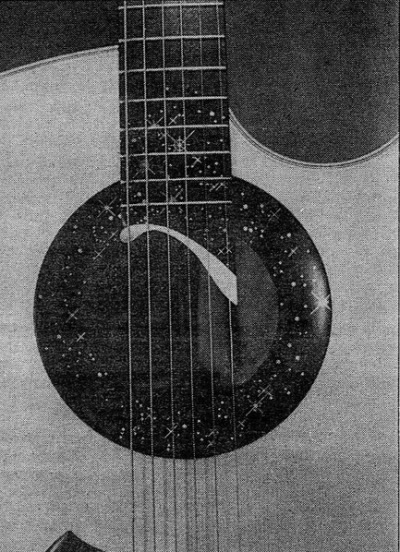 The headstock plaque (of pre-ban ivory that Steve got from John D'Angelico) is in reference to Joni's album "Don Juan's Reckless Daughter," her most experimental Jazz album, featuring Jaco and all the members of Weather Report, a forty piece orchestra (and a bunch of "Guatamalan Insanity Pepper" sessions, I imagine). http://youtu.be/Mdfk17EKGa0  I wrote an article about guitar history and modern luthiers for a magazine, and in the process I interviewed Steve Klein. Joni's guitar happened to be there for "service" (I honestly don't know what that entailed) but I got to play it, along with twenty or so of the instruments he had laying around. (More on that later.) Here's an interesting tidbit you won't find anywhere else: his mother was a librarian, and Steve was an only child. Every day when he got home from school, there was a note on the fridge from his mother listing chores, shopping lists etc., with the items grouped by {brackets}. Steve really likes {brackets}. See how many you can spot. 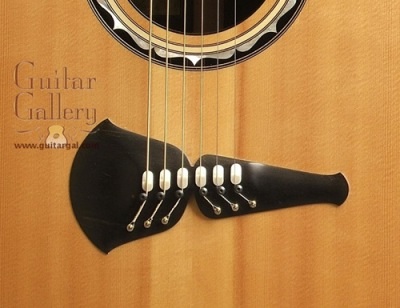 Here is a brilliant article about Kasha bracing (and its failings) by William Cumpiano, author of "Guitarmaking: Tradition and Technology," one of the best books (and schools) about wood and wire: http://dolcecano.blogspot.com/2011_04_01_archive.html#8591961888773614586 More recently, Cumpiano captured my sentiments (underwhelmed) about Kasha-braced guitars; --------------------------------------------------------- "I'm not an advocate of the Kasha system, so I'm not the best source of detailed information on it. Michael Kasha has been extolling the system's virtues for over a decade, and through a handful of zealous advocates has been trying to mainstream the system. It just hasn't caught on. ... ... He's gotten a lot of enthusiastic press and lot of earnest and proselyte followers, but it just has not caught on. The ear is the final arbiter, and it apparently just does not meet up to that final test. Let alone that it is far, far more complex than standard systems without the obvious increment in sound quality that would justify it. Now if you're interested in a radical cutting edge system, take a look at the lattice bracing system, as introduced by the Australian luthier GREG SMALLMAN. [see below] Now there's a noticeable and dramatic improvement in power with only a modest increment in complexity. I'm experimenting now with transferring the system to steel string tensions. Stay tuned. As for Kasha, I don't know: if you're impressed, follow it to where it will take you. But I am not." --------------------------------------------------------- Please take a moment to watch this video of the legendary English classical guitarist John Williams visiting with Greg Smallman (mentioned by Cumpiano, above) at his shop in Australia. As Williams mentions, he had been playing a Smallman guitar for about a decade at that point with no idea why it sounded so incredible. The brief shot of Smallman's "lattice system" in this video is the lone explanation I could find anywhere. http://youtu.be/tCtalGJcP8A A similar idea that's arisen lately is what are called "double tops" or "hollow tops." Made by compositing ultra-thin wood soundboards with a honeycomb lattice made of a fireproof material called "Nomex." (Firefighters wear protective outerwear made of Nomex.) 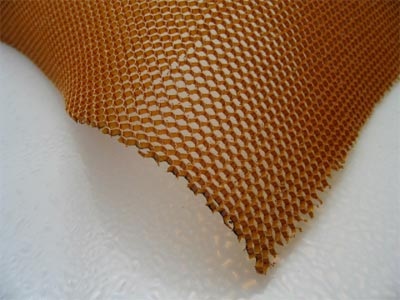 Here is the Luthier's Mercantile page about Nomex, with two excellent, brief videos about its use. http://www.lmii.com/products/mostly-wood/tops-tonewood/nomex William Cumpiano has some definite opinions. Here's one of my favorites: http://dolcecano.blogspot.com/2010_01_01_archive.html#8741215902571577177 I'd like for this to be the start of a conversation about innovations in acoustic instruments, so everybody pile in. You never know where the next great idea will come from. Next up: Larry Fishman has reinvented pickups. Wait 'till you see THIS. | ||
| lbpesq
Senior Member Username: lbpesq Post Number: 6258 Registered: 7-2004 |
Forest: Are you familiar with Al Beardsell's instruments? Bill, tgo | ||
| bigredbass
Senior Member Username: bigredbass Post Number: 2474 Registered: 9-2002 |
Forrest, since you got to hang with SK for a while, did he mention or do you know the cause of his animus with Bob Taylor regarding that acoustic bass guitar they partnered on years ago? It got to the point that Klein was advertising on his then-website to 'build one for you the RIGHT way'. Actually, there's a 'green guitar' possibility that would sell like hotcakes: Instead of Kasha bracing, you could use several of the Kashi food products (tastes like wood, should behave like it), could partner with them on the advertising. I'm pretty sure that advertising 'No Mex' as a feature is probably politically incorrect ! Joey | ||
| ed_zeppelin
Intermediate Member Username: ed_zeppelin Post Number: 129 Registered: 2-2010 |
I wasn't familiar with Beardsall, but I can't thank you enough for turning me on to him. I'm blown away. He's one of the best luthiers ever. http://tinyurl.com/od7ea8t "... what fits the eye fits the hand, what fits the hand, fits the ear. The musician requires the smoothest path to expression, and as a tool of that expression, the instrument should not fight that. This is what I sometime refer to as “transparent interface”—how ideas become sounds with the least possible effort or discomfort. To that end I have incorporated a number of ergonomic elements—the armrest bevel on the lower bout ... 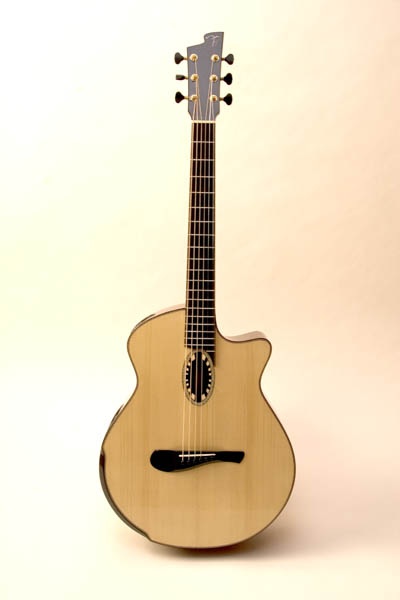 the way the cutaway moves into the heel, and the neck shaft that is asymmetrical to make it more comfortable for the hand... ." -------------------------------------------------- I love some of his innovations, particularly the sliding baffle on the side-mounted sound holes. I've never seen that before. You ever had one of those moments that changes everything? I had one of those at NAMM in Nashville. I don't know if you've ever been to a NAMM show, but the cacophony is deafening. I walked in the door and through all that racket I could clearly hear an acoustic guitar. I started walking toward the sound and it just got clearer and louder. It turned out to be an exact copy of Django Reinhardt's guitar - unamplified! I became really interested in Mario Maccaferri's extraordinary designs. In particular, the unique "petite bouche" ("small mouth" or small oval soundhole) models favored by Django. His rhythm guitarists almost always used D-hole guitar, as did Django himself on occasion. Note the soundhole on the Beardsall (the teeth are a cool touch). I can save you a bit of time and confusion by explaining that Maccaferri made a guitar and took it to Selmer (who were like the General Motors of wind instruments at the time). Selmer agreed to make the guitars, and for about a year or two, they followed Maccaferri's designs (the dude was like the Tesla of acoustics, too) 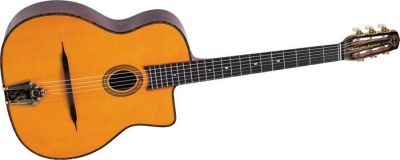 Then they cheerfully fired him when Django Reinhardt became all the rage and Selmer started doing all kinds of things to the guitars. So in France they're known as Selmer guitars but everywhere else, they're Maccaferri guitars. Maccaferri's ideas included an "internal resonator" ... 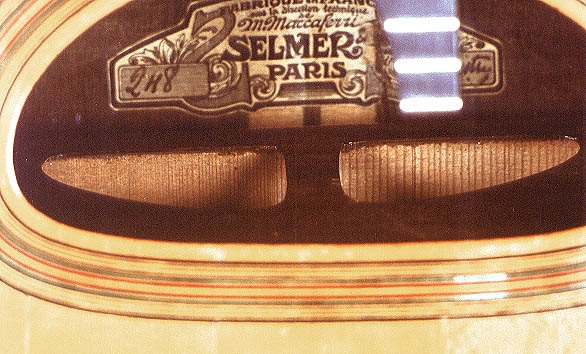 ... and a slightly bent top (rather than a carved archtop, he used a conventional soundboard gently steamed and bent over "ladder bracing" so that the bridge and soundhole were about a quarter inch above the rim) and an extremely thin, long bridge. The weird thing is that the small mouth ones are MUCH louder than the ones with the big D-hole. I think the internal resonator must have been like the "Virzi Tone Producer" Lloyd Loar originally installed in the Gibson Master instruments. http://www.maestronet.com/forum/index.php?/topic/259792-virzi-tone-producer-1924-violin/  Those have become some of the most valuable instruments on earth (especially F5 mandolins), but at some point they were taken apart to remove the Virzi Tone Producer, despite the fact that by most accounts they sounded terrific. Look, if I wind up buying a Beardsall guitar, I'm blaming you. I think that's what it comes down to.  | ||
| ed_zeppelin
Intermediate Member Username: ed_zeppelin Post Number: 130 Registered: 2-2010 |
>>>Forrest, [its one "R," like a bunch of trees] since you got to hang with SK for a while, did he mention or do you know the cause of his animus with Bob Taylor regarding that acoustic bass guitar they partnered on years ago? ...<<< --------------------------------------------- All I can say is that Steve Klein is one of the nicest, most humble people I've ever met, and a creative genius. I know nothing about the bass or Taylor. --------------------------------------------- >>>>>Actually, there's a 'green guitar' possibility that would sell like hotcakes: Instead of Kasha bracing, you could use several of the Kashi food products (tastes like wood, should behave like it), could partner with them on the advertising. I'm pretty sure that advertising 'No Mex' as a feature is probably politically incorrect ! <<<<< ------------------------------------------------ What's "incorrect" is that when Kellogg's bought Kashi and moved the operation to Battle Creek, they changed everything. Instead of "organic" (a label regulated by USDA and other regulatory bodies), Kellogg's changed it to "All natural" (a term that means whatever you want it to.) Kashi is made with GMOs and "conventional" ingredients. For people who still believe Kashi is organic (I've seen it in health food stores), it's one of the worst frauds ever perpetrated on consumers. When confronted, Kellogg's issued this statement; "The FDA has chosen not to regulate the term 'natural.'" | ||
| elwoodblue
Senior Member Username: elwoodblue Post Number: 1724 Registered: 6-2002 |
When confronted, Kellogg's issued this statement; "The FDA has chosen not to regulate the term 'natural. Well that's just GRRRRRrrrrreeeat ! Some really amazing instruments brought up, thanks Forest and Bill. Kaz Krawczak... I wish there was more explanation of Kaz' designs,maybe I just need to dig more- 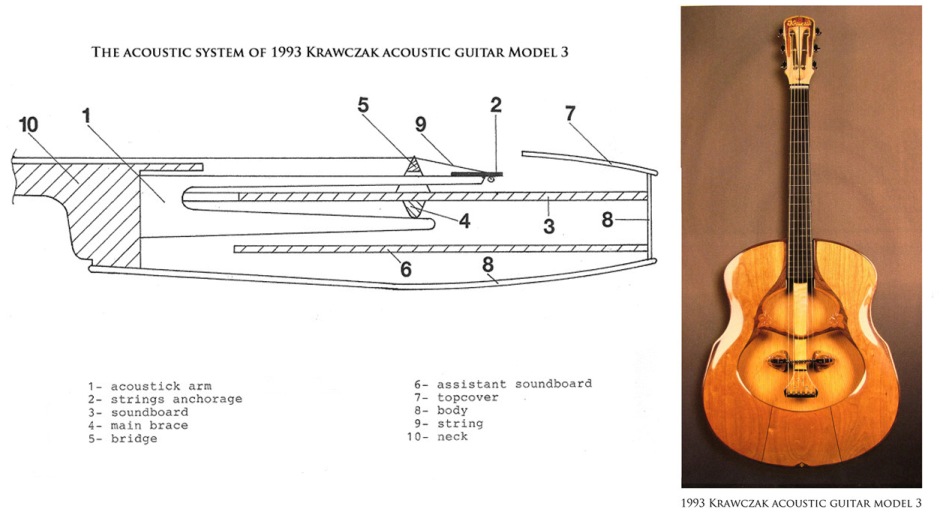 (from here ) ...and this for fun- 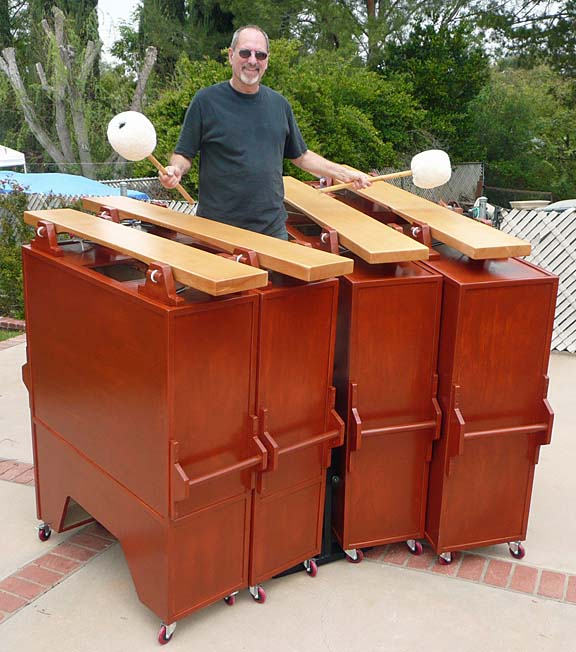 http://microfest.org/genesis-of-an-eroica/ | ||
| lbpesq
Senior Member Username: lbpesq Post Number: 6259 Registered: 7-2004 |
A few years ago, following the Alembic Gathering, Henry Kaiser invited Jonathan Levine and I back to his house to check out his collection. He had two Beardsells, of which I had never heard of at the time. Jonathan and I played them and were both blown away. I scoured eBay for six months and one actually turned up in Florida. I jumped on it. I don't have have the sliding baffle, but I do have two side ports. It's the only acoustic I've played that sounds as good or even better with light strings. Both my 20 year old Taylor 810 and my '53 D-28 sound much better with mediums. This renders the Beardsell the easiest playing acoustic I've owned. It has replaced the '53 Martin as my number one player. Bill, tgo | ||
| jalevinemd
Senior Member Username: jalevinemd Post Number: 1056 Registered: 12-2003 |
They were amazing guitars! | ||
| bigredbass
Senior Member Username: bigredbass Post Number: 2475 Registered: 9-2002 |
Old wood . . . . now. http://www.yamaha.com/about_yamaha/research/are/?from=global_search Joey | ||
| ed_zeppelin
Intermediate Member Username: ed_zeppelin Post Number: 132 Registered: 2-2010 |
For a third day, I've stared at that Kaz whatsisface guitar and tried to figure out what's what on the diagram and compare it to the picture, but that guitar looks like the ugliest baby I've ever seen. 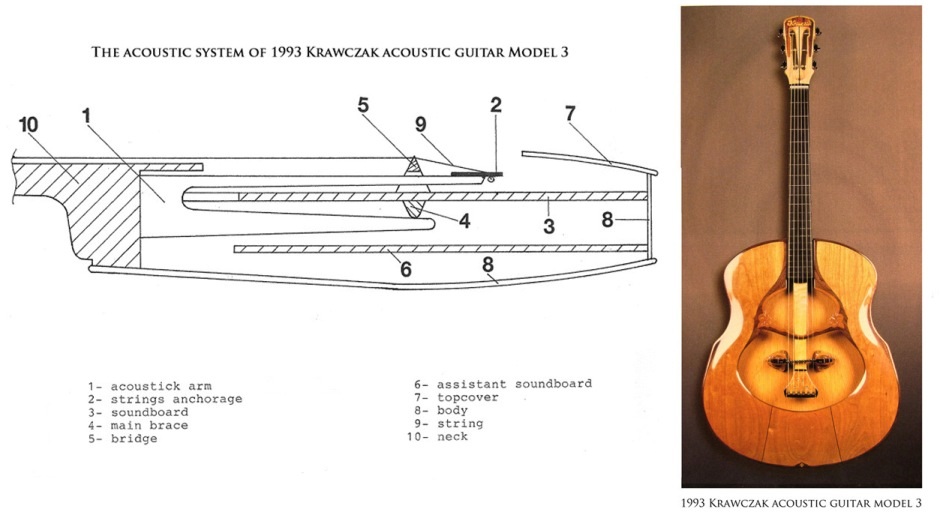 An ugly baby in Geiger eyewear. It kinda freaks me out a little, to be honest. My reason for posting, though, is to point out something from my previous post because it's so important. (Let's face it, with the way I write it's more like plucking a particularly comely turd from a septic tank.) Its worth noting because it's the wave of the future. The first major change in acoustical PROPERTIES (<- in my astoundingly humble opinion) since Torres standardized fan bracing way back when (I'd look it up, but I'm on a roll). >>>"As Williams mentions, he had been playing a Smallman guitar for about a decade at that point with no idea why it sounded so incredible. <<<< http://youtu.be/tCtalGJcP8A So far it hasn't worked out the same for steel string guitars, but the structural strength is probably amazing. Richard Schneider was the first guy to put the soundhole on the upper bout, in the early 80's. But the most intriguing thing about those guitars, if you ever get to see one, is that he cut up a couple of Garcia graphite fishing rods for braces. The damn things are sonic cannons, and with a few changes you could probably dig your car out of a snow bank with one if you had to (as far as I'm concerned, that's what Gibson basses are for. Ptew). | ||
| bigredbass
Senior Member Username: bigredbass Post Number: 2478 Registered: 9-2002 |
Since we have the wonderful luxury of having not one but TWO guitar repair guys in the neighborhood now, what do you you two think about PLEK ? Joey | ||
| bigredbass
Senior Member Username: bigredbass Post Number: 2479 Registered: 9-2002 |
Since we have the wonderful luxury of having not one but TWO guitar repair guys in the neighborhood now, what do you you two think about PLEK ? Joey | ||
| lbpesq
Senior Member Username: lbpesq Post Number: 6271 Registered: 7-2004 |
Before we hear from the pros, I'll jump in as an amatuer tech, (I do most of my own repairs, and all my set ups), and from personal experience, to thoroughly endorse PLEK, at least for electric guitars. I have a few guitars that were PLEKed at Gary Brawer's shop in San Francisco. They play wonderfully. Bill, tgo | ||
| ed_zeppelin
Intermediate Member Username: ed_zeppelin Post Number: 149 Registered: 2-2010 |
I knew nothing about PLEK, so I've been doing a lot of research. Overall, I'm very impressed by its precision and adaptability, but it has some issues. There are only 16 PLEK machines in North America, a quarter of them in California. I can't find the cost of the machines (there are two, the PLEK Pro and the PLEK station) but when I checked the websites of the companies that had PLEK machines (and printed their rates), the lowest price I found was $225 for a basic setup and $500 for setup and new nut. The other aspect that's important to know is that hundreds of shops use Dan Erlewine's "Neck Jig Workstation" http://www.stewmac.com/Luthier_Tools/Types_of_Tools/Jigs_and_Fixtures/Erlewine_Neck_Jig_Workstation.html Which basically does a lot of the same stuff: namely, it locks the neck and body in the same position as when it's under tension from strings. Granted, it's low-tech (the PLEK Pro uses an auto-CAD system to do the actual refinements, where the Erlewine jig just gives the repairman a stable platform to work on), but it doesn't add much to the cost of regular setups, if at all. Plus, like I said, there are hundreds of them around. Dan even sold the plans to make your own jig, for 15 or 20 years. (Hell, he GAVE them to me at an ASIA symposium.) according to PLEK, Dan endorses them, which gives you an idea of the difference between the approaches. Technology always follows the same path: at first it's rare and expensive, then as it becomes more ubiquitous, manufacturing costs come down and the market improves - or it dies a horrible Atari/Steinberger/Trace-Elliot "death of a thousand cuts" - but if it catches on, costs to the consumer comes down. Overall, I think PLEK sounds like it'll make your guitar as close to perfection as ... um ... MACHINE-ly possible. I'm enthusiastic about it, and really hope it catches on. However, the exchange rate with Germany (and the implication; "if you have to ask how much it costs, you can't afford it") leads me to suspect that PLEK machines are astronomically expensive, therefore shops have to pass the expense on to consumers. | ||
| ed_zeppelin
Intermediate Member Username: ed_zeppelin Post Number: 150 Registered: 2-2010 |
Maybe somebody can help me out with this, because it's implied by its glaring omission: I don't see how the PLEK handles compound radius. A HUGE part of working on other people's instruments is understanding each one's affinity for flat or compound radius (sorry, I just can't use "radii," or the thumping of my Okie ancestors whirling like camshafts in their graves would sound like a drum solo by a Tourette's sufferer on orange sunshine): Knowing the difference in a cylinder and a cone, is what it comes down to. And I don't think PLEK does. That's why I'm asking for help to ascertain that aspect. Every player, style of music and most of all: whatever's on the body side of the neck joint, influences the degrees between the two shapes; cylinder or cone. The degree to which the repairman can influence one toward the other is also very limited. Here's the kicker: most players aren't aware of it, and at some point just go; "I don't know why, but this [insert instrument] plays weird." Please don't take this as condescension, because I have so much to learn but I thought I'd tell you how a repairman looks at it and where the science and art meet. It's rudimentary stuff, so please bear with me if you already know it. We look at it as a grid. I hold the instrument toward a good light source and sight down from the bridge to the headstock from the end, and as you gently dip the headstock up and down, the frets and the string plane form a grid. I look at it like a sailboat, with the neck as the mast and the bridge as the deck. Except instead of being supported by guy wires all around, they're all on one side (the strings). The only things countering that force is the truss rod, the rigidity of the neck wood (hence the popularity of maple, especially 1950-60s Teles, because they also made dandy weapons in bar fights) and the design of the neck. Cylinder or cone, or both. By holding the neck at just the right angle, you make all the frets line up into one mass, and as you slowly lower it the frets spread out. I don't look at the frets themselves as I do this, because flaws show up far more easily by looking at the SPACES between frets (the eye is always drawn towards light colors, something I learned from an "easy 'A'" art appreciation class that was actually useful). The art and science meet when you compare the two planes: the one made by the strings and the one made by the grid. That's when I put my CSI cap on (figuratively, of course. I can't stand that silly show) - because it's somebody else's guitar, rule #1 - and figure out as much as I can about the player, and what they want. Is there a lot of fret wear in first position? ("House of the Rising Sun" fret wear, I call it.) Is the fret wear even? Virtuosos tear up the tracks between about the 9th to 20th frets, 5th to 14th on acoustics, which is why there's so much bloodshed over the "bolt-on vs. neck-thru" arguments. Is there pick wear on the rose? (For acoustic. We tend to assume every electric player uses a pick.) And that's where the art is: combining those factors into how you align the string plane to the grid. Figuring how much "fight" a player needs (or the limitations of cheap instruments), how deep to cut the slots in the nut (gawd, I love me some zero frets) and how much "cone" you might need on a "cylinder" (most easily seen by the differences between a flat-as-a-board classical fingerboard and Santana's Paul Reed Smith "cone" compound radius, setup to such insane tolerances that NASA scientists were brought in to measure it. I want to be clear; I'm not saying the PLEK can't handle compound radius, just that they don't say they CAN. Cletus says; "yeah, but can a PLEK do THIS?" 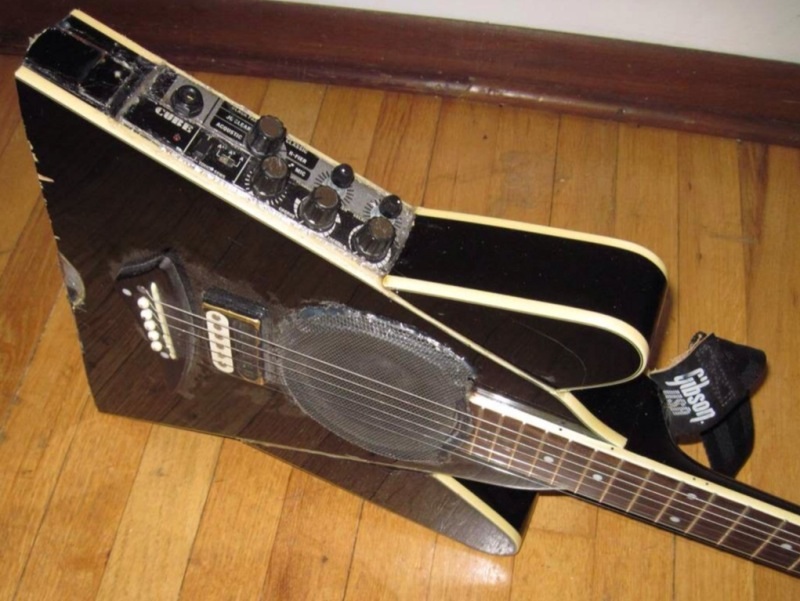 | ||
| bigredbass
Senior Member Username: bigredbass Post Number: 2480 Registered: 9-2002 |
FWIW, I was quoted $175 (and I furnish the new strings, same as currently installed) and a 2-3 week turnaround by Joe Glaser's shop (a first-class tech, and interestingly, the USA distributor for PLEK), which I thought was just crazy. Forest I understand the basic process, but I suppose my real question is that for the life of me, I can't imagine that it replaces a first-class tech's set-up who's willing to tweak with the player to get it just right for that individual. Nor do I think that it's beyond me (bearing in mind that my two axes are in good shape with no fret issues or serious twist/relief/grooves in the fingerboard) to maintain my own axes in their current shape. And I'm always quick to point out that my own method is ENTIRELY derived from Dan. Joey | ||
| bigredbass
Senior Member Username: bigredbass Post Number: 2481 Registered: 9-2002 |
FWIW, I was quoted $175 (and I furnish the new strings, same as currently installed) and a 2-3 week turnaround by Joe Glaser's shop (a first-class tech, and interestingly, the USA distributor for PLEK), which I thought was just crazy. Regarding the capacity to intake a compound radius, wouldn't it just automatically store the changing radius as part of its' initial survey? Forest I understand the basic process, but I suppose my real question is that for the life of me, I can't imagine that it replaces a first-class tech's set-up who's willing to tweak with the player to get it just right for that individual. Nor do I think that it's beyond me (bearing in mind that my two axes are in good shape with no fret issues or serious twist/relief/grooves in the fingerboard) to maintain my own axes in their current shape. And I'm always quick to point out that my own method is ENTIRELY derived from Dan. Joey | ||
| bigredbass
Senior Member Username: bigredbass Post Number: 2482 Registered: 9-2002 |
Oh yeah, I forgot to include . . . . I had a friend who was a fabulous fiddler who worked on his own five-string violins (he wanted to include the low C to mimic viola timbres in spots), and he would sand / flatten out the high end of his fingerboards after reading about that sort of things on guitars. Is that common with fiddlers? And, delving into Tales from the Bench . . . . I learned to adjust my own axes after several really good techs just could not understand why I wanted lower strings on a bass. I just didn't understand why would you NOT want an instrument (that's already harder to fret) to play as easily as was possible with any given axe. I heard ' . . .but it's gonna buzz . . . ' once too often. Are most bass players THAT ham-fisted technique-wise, or do the techs just hide behind the 'well, that's adjusted to the factory spec' reasoning? Joey | ||
| ed_zeppelin
Intermediate Member Username: ed_zeppelin Post Number: 151 Registered: 2-2010 |
As Mark Twain said; "I was born humble, but it wore off." My last shred of humility is all that stands between me launching into a rant about why you can't get - and don't want - the action on your bass to be just like your Gibson 335, here, on Alembic's forum. It would be like marching into a Learjet factory and announcing in a loud, clear voice; "you're doing it all wrong! It costs too much! Take off those flat things sticking out of the sides!" Don't worry, I'm not calling anyone a moron, except me. There are forces at work here far beyond our ken. (The Foghorn is Scottish, y'know. She actually says stuff like that, and after centuries of marriage, I do too.) Alembic are the acknowledged masters of uniting the forces of wood and wire to perfection. There are so many factors at work in matters of string, scale and sound - and Alembic's solutions address each in their own unique way, such as the adjustable nut, or that masterpiece of engineering: the Alembic bridge, and even the slotted tailpiece for those of us who change strings a lot - that I'll just admit my ignorance right up front and get it over with. Besides, no other musical instrument maker has gone to such great lengths to make sure you can adjust every single factor of your action (nut, neck and bridge), so if the action on your Alembic bass isn't perfect - PERFECT - that just means you ain't tryin'. Here's a little glimpse through a window into just one of the main factors that musical instrument makers confront (with nifty animated gifs, my favorite part.): https://plus.maths.org/content/why-violin-so-hard-play I don't know how they could have explained that without the animated gifs, y'know? As for fiddles, hold up your left hand and spread your fingers as wide as you can (mmbaby). On a violin, that's an octave, pretty much. No frets. It's like playing whack-a-mole with fleas. And bowing (arco) is a whole different beast, that instantly maximizes a string's oscillation and unleashes harmonics you can't imagine. Not all of them good. Taming those suckers is an art in itself. I'm too lazy to find the link (it's somewhere in this thread, I think) to the National Musical Instrument museum in Vermillion, South Dakota, but I noticed that in their notes on a Stradivarius or Amati violin that it was the ONE violin by that maker that had the original, unaltered neck. (It was virtually untouched.) That kinda floored me. For hundreds of years, guys with varying degrees of skill and knowledge thought nothing of ripping the neck off a violin and doing this to it: 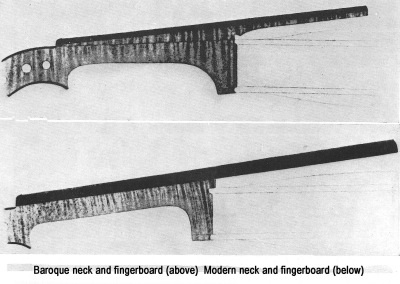 ... and you're asking me why your pal takes sandpaper to his fiddle? No repairman in his right mind would tell him not to, either. "Go ahead, knock yourself out. Wanna borrow my belt sander? Here's a hammer." | ||
| lbpesq
Senior Member Username: lbpesq Post Number: 6273 Registered: 7-2004 |
"My last shred of humility is all that stands between me launching into a rant about why you can't get - and don't want - the action on your bass to be just like your Gibson 335, here, on Alembic's forum." I suspect the late, great, Mr. Entwistle might have disagreed. So long as the intonation works, there is no universally "wrong" way to set up an Alembic. "Wrong", in this context, is an individual assessment. What is wrong for one person may be the epitome of perfection for another. The beauty of Alembics is that they can relatively easily be adjusted to each person's own style. Bill, tgo | ||
| tubeperson
Senior Member Username: tubeperson Post Number: 521 Registered: 5-2005 |
Here, here Bill TGO. So very true! | ||
| ed_zeppelin
Intermediate Member Username: ed_zeppelin Post Number: 152 Registered: 2-2010 |
I'm surprised you don't understand the most fundamental difference between bass and guitar, Bill. A .105 string on a 34" scale neck is going to oscillate a lot more than a .64 on a 24.5 scale neck. For instance, Clapton likes .064" action at the 12th fret on his Strat (we measure that with these: http://www.stewmac.com/Luthier_Tools/Types_of_Tools/Straightedges/String_Action_Gauge.html ) Try to set the action on an Alembic bass to .064" Bill. It'll sound like somebody set a rabid ferret loose in your cutlery drawer. Just because you can doesn't mean it'll sound good. As for John Entwistle and Alembic, roundwounds were virtually unheard of until Entwistle and James How developed the Rotosound Swing 66 set. I'm guessing they knew how much more a bass string oscillates than a guitar string, and that a P-bass E string needs more clearance from the frets than a low E on a Gibson 335 (which was my point). How much more? I dunno. Alembic made his basses, ask them. Only an idiot would come to their forum and claim they knew exactly what he wanted. The animated gifs were cool, though, weren't they? That fourth one, that shows the confluence of multiple waves up and down the string simultaneously, is exactly the same theory as the production of "rogue waves" in the ocean that can sink huge ships. Think about that next time you go out on a boat. It blows my mind that a bowed string oscillates in a triangular pattern, or how Helmholtz could figure that out 150 years ago, using mathematics. Anybody want to venture an opinion on how those "Helmholtz" things apply to an Ebow? (Message edited by Ed_zeppelin on October 19, 2015) | ||
| elwoodblue
Senior Member Username: elwoodblue Post Number: 1733 Registered: 6-2002 |
It sure seems the Vo-96 belongs in this thread- https://www.youtube.com/watch?v=psqPViFKkjg | ||
| ed_zeppelin
Intermediate Member Username: ed_zeppelin Post Number: 153 Registered: 2-2010 |
Wow! That thing is amazing! I use a Godin ACS (Buster Jones style) with a Roland GR-1 for that acoustic/synth thing. http://www.godinguitars.com/godinacsp.htm You're right, though. This is the right place for the VO-96 because he completely re-thought the whole thing. Have you seen the sliders on the control panel, with LEDs that vary in brightness according to the setting? Holy cow, what a brilliant, completely original design. And so elegant and simple. http://voinventions.com/  It looks a little clunky, but the only visible part is the surface, and the controls are worthy of Michelangelo or Frank Lloyd Wright. Absolutely unique, from the ground up. I bet that whole thing will be the size of an iPhone in a couple of years. It actually is an acoustic synth, too. It's digitally processing the acoustic properties of the strings and guitar (that's why it takes him ten minutes to explain it). Did you see the other product he makes, the "Wond" (my award for lame name of the decade, though, especially because it was called "the Vo Wand," a far more euphonious and mellifluous appellation). It's like an eBow on steroids. I was just talking about eBows, too. | ||
| elwoodblue
Senior Member Username: elwoodblue Post Number: 1735 Registered: 6-2002 |
I've done the Cletus method that involves an extra amplfire with a speaker duct taped to the back of a mexican strat. I can simulate controlled stage level feedback at headphone level(with a nice HF roll-off since it's re-amped through the body). That moog really adds a crazy amount of control; dampening as well as driving! I'll have a look at the Wond, I missed that. | ||
| adriaan
Moderator Username: adriaan Post Number: 3274 Registered: 6-2002 |
@ed_zeppelin - John Entwistle's preference for extremely low action is well documented, and it was unplayable for most people. | ||
| keith_h
Senior Member Username: keith_h Post Number: 2308 Registered: 2-2005 |
There are a number of people here who are well versed in John Entwistle's basses, Alembics in particular, and how he liked them setup. As far as bass setups go I guess mine is setup wrong as I set my "E" string to 1.7mm to 1.8 mm at the 24th fret. That would be .066 to .070 inches making it pretty close .064 inches. The neck itself is fairly straight with minimal relief and plays just fine for me. I'm not the only one here who sets up my bass in that territory. You could make an argument for an acoustic bass where the volume is directly related to how hard you pluck. However with an electric bass there is no need to pluck hard for anything other than dynamics as the amplifier handles the volume. I think Bill stated it quite succinctly when he said, "there is no universally "wrong" way to set up an Alembic. "Wrong", in this context, is an individual assessment." Keith | ||
| ed_zeppelin
Intermediate Member Username: ed_zeppelin Post Number: 154 Registered: 2-2010 |
Sorry about taking so long to respond, but I was struck by the irony of setting off a controversy over whether a bass string oscillates more than a guitar string - here, on Alembic's forum - and the shock wave knocked me off my chair, out the window and into my neighbor's rosebushes. I suspect it was this comment that sparked off the controversy: -------------------------------------------------------------------- "As for John Entwistle and Alembic, roundwounds were virtually unheard of until Entwistle and James How developed the Rotosound Swing 66 set. -> I'm guessing they knew how much more a bass string oscillates than a guitar string, and that a P-bass E string needs more clearance from the frets than a low E on a Gibson 335 (which was my point). <- How much more? I dunno. Alembic made his basses, ask them. Only an idiot would come to their forum and claim they knew exactly what he wanted." --------------------------------------------------------------- I stand corrected. John Entwistle's bass strings did not oscillate more than a guitar string, and anyone who suggests otherwise out to be horsewhipped. I wonder who dragged up Entwistle in the first place? Not that I mind. Look, "Live At Leeds" rocked my world. I'm with you. When you find the sumbich who said he set his basses up "wrong," let me know and I'll join the "mass frowning." Thanks for the heads up. | ||
| elwoodblue
Senior Member Username: elwoodblue Post Number: 1737 Registered: 6-2002 |
Did you notice the "future mystery connector" on the Vo-96 diagram? | ||
| ed_zeppelin
Intermediate Member Username: ed_zeppelin Post Number: 155 Registered: 2-2010 |
I didn't realize until I tried to find it that unless you go to http://voinventions.com and select VO-96 (under "products"), nobody would know which video I was talking about. Here's the YouTube address, to save you the trouble: http://youtu.be/rDaKfG3-dtA He demonstrates the touchpad/slider/LED thing at 2:38. Tell me that isn't one of the most elegant, simple, unique solutions you've ever seen. I can see putting one on the back of a guitar neck, to control volume with your left hand (or to switch functions, whatever. Sky's the limit.) Especially because the brightness of the LED indicates the position of the slider. All the zillions of mixing boards, amps and other stuff with sliders out there, and nobody ever thought of that (as far as I know). Speaking of inventions, I'm still working on understanding Kaz Kwzywckxwk's inventions. His site (on tripod.com) hasn't had any activity in eons, but you have to wade through the acoustic stuff to get to his electrics, which are just stunningly innovative. 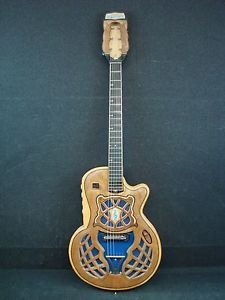 Here's the patent (pdf) for his "acoustic arm" design: http://www.freepatentsonline.com/5661252.pdf 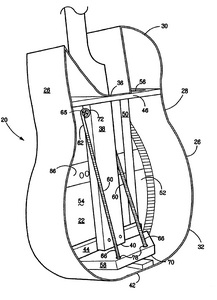 He was really onto something with the arm taking all the string tension everything else about the guitar could change, since the bracing doesn't have to bear any stress other than keeping a vaguely guitar-ish shape. The trick is in how the strings' vibrations are transferred to the soundboard, and that part isn't particularly clear. (Plus, you really don't know if it's bogus unless you can actually hear it, y'know?) Kind of clunky headstocks, as well. 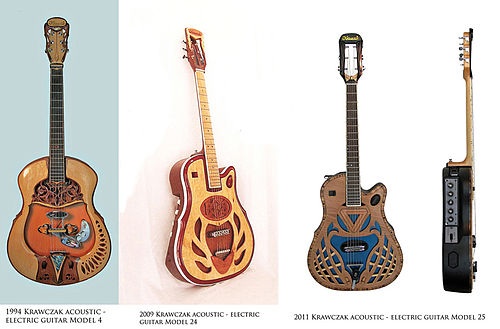  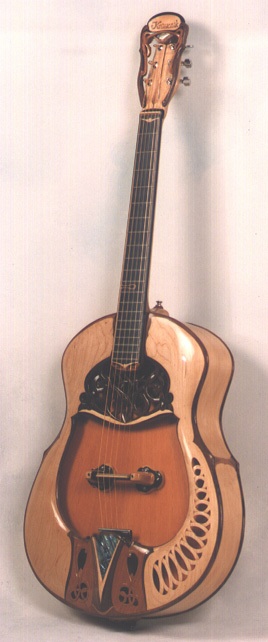 | ||
| ed_zeppelin
Intermediate Member Username: ed_zeppelin Post Number: 159 Registered: 2-2010 |
One of the most fascinating aspects of Kaz' ideas is that he's Polish, and entirely self-taught. Just like Tesla. My favorite part is that he came up with his ideas for native instruments, not guitar. You can trace the evolution of an absolutely brilliant mind by how he gradually meshed Polish and Western tastes. Look through those guitars again, it's amazing. I love stuff like that, the evolution of ideas. Alembic is founded on rust, y'know. Does anyone want to crack the code? It's about the evolution of ideas. | ||
| lbpesq
Senior Member Username: lbpesq Post Number: 6274 Registered: 7-2004 |
And, as Mr. Young has taught us, rust never sleeps. Bill, tgo | ||
| elwoodblue
Senior Member Username: elwoodblue Post Number: 1738 Registered: 6-2002 |
The first one you pictured above sold on ebay. The listing has a vid and some good pics.I'm not impressed by the sound of it with the little marshall and that player. Though that could just be due to a hasty choice of settings. Interesting still... ebay | ||
| elwoodblue
Senior Member Username: elwoodblue Post Number: 1739 Registered: 6-2002 |
...and a clunky headstock is putting it mildly once you see the back and closeups...it just seems... unnesscesssary. | ||
| ed_zeppelin
Intermediate Member Username: ed_zeppelin Post Number: 160 Registered: 2-2010 |
>>> ...it just seems... unnesscesssary. <<< Like a spellchecker? They look downright malicious, ready to trap the fingertips of the unwary when they try to tune. I can't for the life of me figure out what that's about. Some kinda anti-theft thing? (Like Ted McCarty on the Gibson Moderne; "let's make a guitar too ugly to steal!") | ||
| elwoodblue
Senior Member Username: elwoodblue Post Number: 1740 Registered: 6-2002 |
I was hooping you'd notice hat. I've got a homebrew electric made my James M. Lewis.It has a wacky headstock and some other interesting things going on. I'll have to post some pics and a soundclip. It has what sounds like an active boost, but I haven't found the battery??! I'm almost done replacing the stock emg pots with new bourns low friction on my G&L Skyhawk. I'll get to pix after that. | ||
| hammer
Senior Member Username: hammer Post Number: 780 Registered: 9-2009 |
We suggest that students at the University do that all the time to their nice bikes. Get yourself a can of flat black spray paint and sort of cover your bike. No one will touch it. Of course a friend of mine decided to do that to his car a few years ago. Purchased a dozen cans of lime green spray paint, did a little taping off and went at his 1973 Toyota Celica. His car ended up not looking half bad. Unfortunately, he painted it in a shared garage with two other cars (that were not lime green) and their owners were not too pleased when they discovered how much "drift" you get when painting with a can of spray paint in a garage on a windy day. You would think that a guy who eventually would become the Dean of the College of Education at the Univ. of Virginia (a fine institution of higher learning) would have thought this through. We will leave it to the lack of wisdom we all have at a young age. | ||
| ed_zeppelin
Intermediate Member Username: ed_zeppelin Post Number: 161 Registered: 2-2010 |
>>> You would think that a guy who eventually would become the Dean of the College of Education at the Univ. of Virginia (a fine institution of higher learning) would have thought this through. We will leave it to the lack of wisdom we all have at a young age. <<< Makes perfect sense to me. In my experience, he'd be the most likely culprit. C'mon, you know it. "Who painted their car in the garage?" Everybody points at the guy in the tweed blazer with leather elbow patches. "Why I oughta ..." And age has nothing to do with it. I do WAY dumber stuff now than when I was pretty and knew everything. Luckily, my lovely Scottish bride, the Foghorn, keeps track of my flaws and a notable uptick in dumbassery started about three seconds after I muttered "I do" and has escalated unabated ever since. I like to point out an icon of brainlessness, a touchstone of utter stupidity in physical form that is also a story of redemption and joy. The Foghorn and I lived in Half Moon Bay, California, and we bought two male Golden Retriever puppies from a breeder in La Honda, where Neil Young lives. The "breeder" was actually a very well-known musician, but this ain't about him. I only mention it because he owns a ranch adjoining Neil Young's. He threw a big party on the day that everyone came to pick up their puppies. One of the other people picking up their pick of the puppies was Larry Cragg, Neil's guitar tech. We became friends. At one point later on, he showed me Neil's guitar, "Ol' Blackie," a 1953 Gibson Les Paul with ultra-rare factory Bigsby wiggle-stick (made by Paul Bigsby himself). Neil bought it cheap in the Buffalo Springfield years because even though it was an original goldtop, some lunkhead had PAINTED IT WITH BLACK HOUSEPAINT. The reason it's an icon of idiocy redeemed is because even though some moron had looked at it and said; "y'know, I have some black house paint left over from that incredibly stupid idea when I painted the house black, I think I'll paint my Les Paul with it!" - it didn't affect the value one bit. Millions of people know that guitar by sight and sound (mostly snarling, granted), but can you imagine the value of that guitar? To add a delicious bit of irony to this seemingly never ending story: I asked Larry and Rocky (another tech); "when Neil wrote 'Rust Never Sleeps,' did he mean ________?" And they confirmed it. That's as straight from the (Canadian) horse's mouth as it gets. "Hey, who painted my 1953 Les Paul gold top with black housepaint?" Everybody points to the guy in wingtip shoes ... | ||
| cozmik_cowboy
Senior Member Username: cozmik_cowboy Post Number: 1963 Registered: 10-2006 |
A friend of mine (in fact, the one who dubbed me Cozmik Cowboy about 40 years ago) is a flat out genius; PhD in math, plays like 14 instruments, 2 albums of originals, decades as Dean of one of the most intellectual colleges in the country. I've seen him play chess. Without a board. While driving. Back then, he did a drive-away (they need their car moved, you need a ride, so you drive it) from Philly to Chi. Except they didn't make it. Being good, environmentally conscious hippies, they filled the guy's Benz with unleaded (back when leaded was still standard). That would be his diesel Benz....... Peter (Message edited by cozmik_cowboy on October 22, 2015) | ||
| hammer
Senior Member Username: hammer Post Number: 782 Registered: 9-2009 |
I'm not suggesting my friend who spray painted his car in a multi car garage was stupid. Stupid people don't lean from their mistakes. He did. The next time a paint job was needed (after several cans of bondo and some sculpting) he brought out the paint tray and a roller and rolled instead of sprayed the paint on. Of course it took a lot longer for the thicker, rolled on paint to dry so the next day when he drove his still semi-wet car to work it acquired some very unusual streak marks when he hit 70 on the highway. Oh and by the way....the paint he used was Latex and when it started peeling 9 months later he scraped it off and did it all over again. | ||
| sonicus
Senior Member Username: sonicus Post Number: 4560 Registered: 5-2009 |
I once purchased a VW transporter bus ( the ones with no side windows and transfer cases on the rear wheels) It was a 1965 model with an upgraded 1750CC engine with a Borsch Centrifugal advance on the distributor and dual carburetors and an oil cooler and that is why I got it. The downside was that it had been brush painted oil based house paint. It had a CAT painted on one side and a few MICE on the other side trying to evade the pursuit of the CAT. On the roof there was a huge Swiss Cheese painted on with mice looking out of the holes . I was constantly being pulled over by local law enforcement where ever I drove it. IT was inevitable that I would be sanding off the art work sooner then later. I rented a 2 car garage and went to work with my power sander. An acquaintance of mine that I had met about a year before at the beach near the Chet Helm's Family Dog concert hall,helped me spray paint it with his commercial house painting airless rig and donated the paint " Brown oil based metal primer" that was left over from one of his jobs. I no longer was an innocent target and was relieved of that but still wondered why. The solution was just too simple , my young mind was too naive to wrap my head around the shallowness of it all ( or I just had my thumbs in my eyes !) . Well there we have it , some of my old recollections from over 40 years ago !!! I eventually learned how to get my thumbs out of my eyes ! Wolf | ||
| ed_zeppelin
Intermediate Member Username: ed_zeppelin Post Number: 162 Registered: 2-2010 |
I apologize for implying your friend was stupid. Quite the contrary, I just meant that he was human. Okay, I admit the idea of kicking academicians in the pants was irresistible. All I'll say is that anybody who knows me knows why  Everybody thinks that stupid things happen all at once, and my own experience indicates that most of the time, the really monumental acts that Mark Twain called "inspired idiocy" happen in stages. ("Hmm, I think I'll paint the roof of 'the love bus,' my unsuspecting 1965 VW troop-carrier, like a chunk of Swiss cheese! That should snag groovy chicks like crazy, daddy-o!") Being married to a Scot, I began a study of stupidity I call "the un-unified theory of irrelativity" - since I had access to a full-time volunteer chronicler of my steady stream of blunders, errors and miscalculations - and I've come to the conclusion that certain factors of idiocy can be codified. "Forest's Law of Colossal *Four-ups" states that "PEOPLE WHO ARE GOOD AT TAKING THINGS APART ARE RARELY GOOD AT PUTTING THEM BACK TOGETHER." That's an example of what I call an element of stupidity, distilling the science to its smallest essential components. A very popular book way back when was "Your Erroneous Zones" by Wayne Dyer. I'm not recommending it (I wouldn't slog through it again at gunpoint) but I distilled one element from the book: "being crazy has nothing to do with intelligence. There are plenty of doctors and lawyers who are completely nuts." I was sixteen when I read that, and within a couple of months my neighbor - whom I respected - attempted to paint his house a weird 70s "Laugh In" green with his spanky-new Kirby vacuum attachment. (What is it about house paint?) I immediately applied a variant to the rule: "being stupid has nothing to do with intelligence. The guy next door is trying to paint his house with a vacuum cleaner." He was proud of it, too. Told anybody who would listen, and a lot who wouldn't. He'd take all morning to set up, then you'd hear that damn Kirby fire up and he'd make a few feet before the thing clogged up. You could tell how far he got, too, because when it clogged it did this Jackson Pollock-style squirting paint thing, like a signature. He kept saying he'd fix it later; "once I get this damn thing dialed in," but for years anybody who turned onto my street was confronted by the ghastly sight of a beige stucco house covered in lime-green wisps, clots and free-form ejaculations, like a giant Martian had sneezed on it. I'm hoping for a Nobel nod for "Forest's Law of States of Matter: 'AT STANDARD AIR PRESSURE AND TEMPERATURE, THE FASTEST WAY TO TURN A SOLID TO A GAS IS TO FEED IT TO A DOG." Jeez, I've completely wandered from the topic. That was stupid. (See what I mean?) * the original word wasn't a number. | ||
| ed_zeppelin
Intermediate Member Username: ed_zeppelin Post Number: 163 Registered: 2-2010 |
The more strings, the less chances of anyone criticizing your playing.  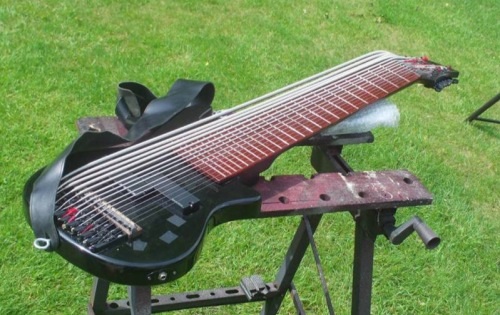 (Can't figure out the pots? Yank 'em and cover the holes with tape. Simple.) Or add knobs (not advisable for balding guitarists, because all the audience will see all night is the top of their head). 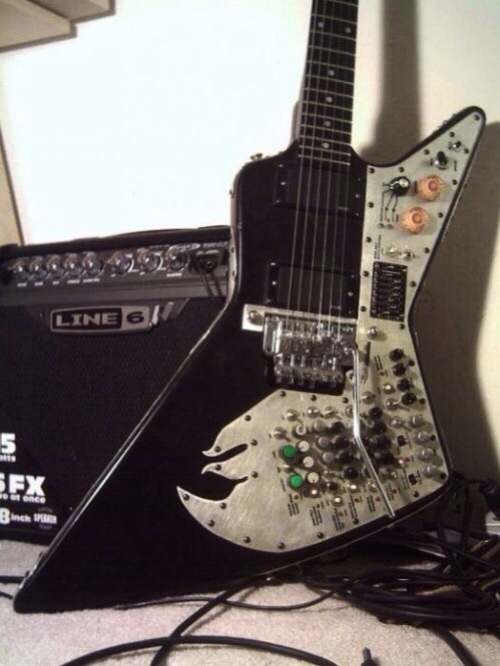 | ||
| cozmik_cowboy
Senior Member Username: cozmik_cowboy Post Number: 1965 Registered: 10-2006 |
OK, I have never, ever wanted an Explorer - until now! Peter (whose guiding philosophy has always been that moderation can ruin anything) | ||
| elwoodblue
Senior Member Username: elwoodblue Post Number: 1742 Registered: 6-2002 |
Here's an odd one,it's hollow like the aluminum fender/harley guitars...but it's wood.There's a center block,but the body is sort of floating around it. The headstock...what can I say...the wooden inlays on the back are really well done (reminds me of my uncles old chriscraft) ,the metal base must have been made by hand, adjusting the truss rod should be real easy, it's light and comfortable to play...oh, and I'm pretty sure I always draw blood when changing strings. I found the battery !! it was stashed in the depths of a hollow. The Vol pot has an emg "V" sticker on it...that might be a clue as to what the band-aid wrapped unit is.It turns the sound from a bic lighter to a flame thrower. I like the jack location too, it works. Gotta check the bread in the oven.cheers! 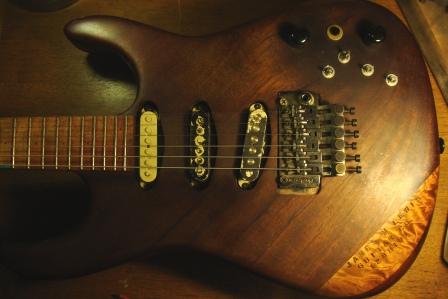 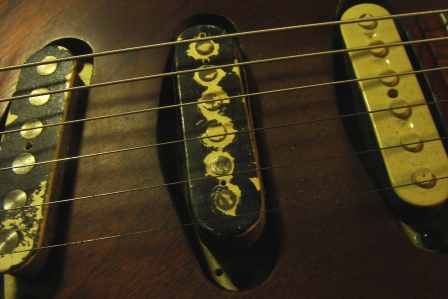  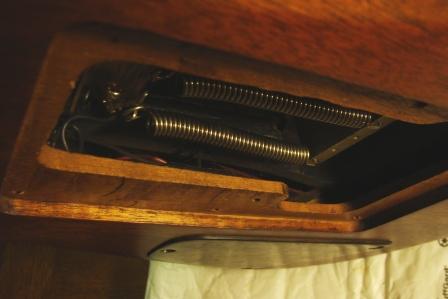 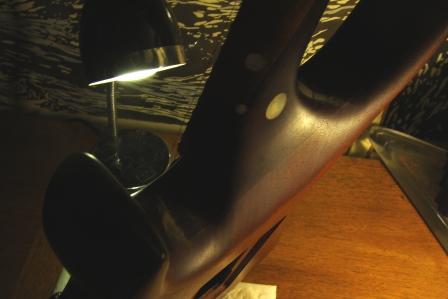  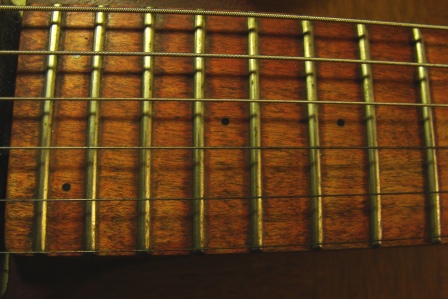  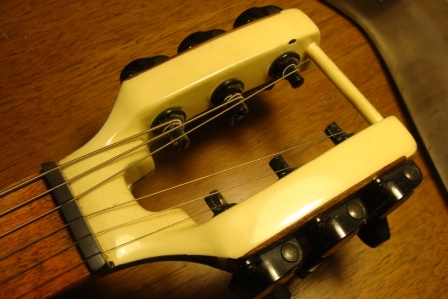 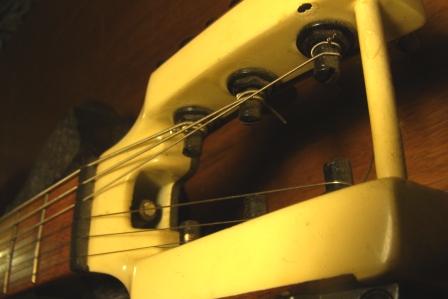 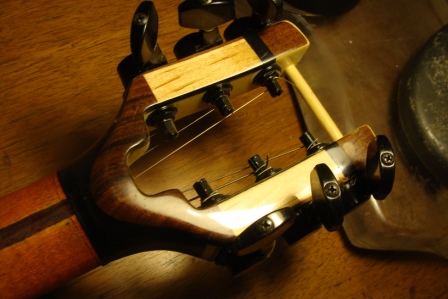  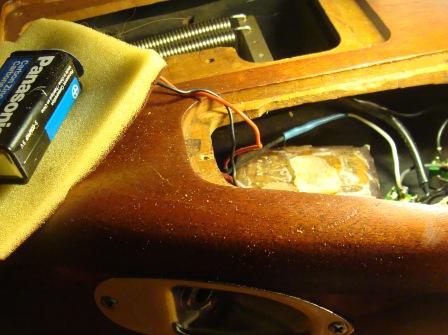  P.S. any help figuring out what those pickups are exactly would be nice, I'm thinking ...1/4pounder,greybottom strat,other fender 70's pup ...?? | ||
| ed_zeppelin
Intermediate Member Username: ed_zeppelin Post Number: 166 Registered: 2-2010 |
There's a little trick you can do to minimize being stabbed by string ends: just before you cut the excess string off, bent it hard in the opposite direction, then cut it. Instead of sticking straight out of the hole, the string stub will be bent and any contact will either brush against your finger (rather than stabbing it) or miss it entirely. That style of peghead is called a "pegbox" and goes back at least 500 years (just imagine a scroll on top). I've never seen it on a guitar before, though. | ||
| elwoodblue
Senior Member Username: elwoodblue Post Number: 1743 Registered: 6-2002 |
That is the method I usually use, I must have been lazy or distracted after the last string change. Those tuners have the auto-cut feature,but if I used it I couldn't get the strings back on if I decided to do some fretwork etc. I thought that bending over the string end was a foolproof way to avoid snags.I was wrong. My guitar and I ended up being sprayed with a fine mist of pepsi light as the other guitarist somehow brushed an unopened can against the end of the 'b' string and being hooked over it grabbed and pierced the can towards the bottom ...it took us several moments to figure out what had just happened. I was glad I had brought a graphite neck ax that day,it made clean-up quick and easy. Since then I've add an extra bend so the string end is tucked a bit more towards the post. If someone asked my what kind of wood the body is, I couldn't tell them for sure...any ideas? | ||
| ed_zeppelin
Intermediate Member Username: ed_zeppelin Post Number: 167 Registered: 2-2010 |
There are so many things I like about that guitar, but a few that make me want to beat my head against the sidewalk. Mainly, the beautiful piece of quilted maple as an armrest is striking, but then ruining it by using a Harbor Freight stamp kit to stamp his name and rather unwieldy serial number in it - without even bothering to line it up correctly - is an abomination. It's like one day he made the guitar body, then skipped his meds for a couple of days before giving in to the voices and breaking out the hammer and stamp kit. Why, oh why? (To be honest, at first glance I thought it had a "sanitized for your protection" banner on it.) That groovy headstock ... glued on with a butt joint? Go ahead, show me a guitar anywhere that costs more than fifty bucks - new - with a headstock glued on with a butt joint. All I'm going by is what's visible (let's hope there's something hidden, like bolts, biscuits, dowels, anything other than Elmer's on a flat butt joint). Which brings me to my next point. A Floyd Rose. My old nemesis. Words cannot describe how I loathe those things, because intonation is a nightmare. Excuse me, six nightmares. It's like herding cats, because every time you get five in tune, you have to go back and redo everything to get the sixth, etc. Those little blocks get jammed in the slots and nothing short of explosives will knock them loose. This thing is a godsend: http://www.stewmac.com/Luthier_Tools/Tools_by_Job/Bridges/The_Key.html Instead of nudging the saddles around, it gives you precise control with a screw. Buy two. You'll see why. Or better yet, build a trebuchet with your friends, stick that damn Floyd in a pumpkin and see how far away from you it'll go. (That's what we call "dynamic range") and drop a Wilkinson in there: http://www.stewmac.com/Hardware_and_Parts/Bridges_and_Tailpieces/Electric_Guitar/Tremolos/Wilkinson_Gotoh_VSVG_Vintage_Tremolo.html For consistent whammosity a Hipshot Tremsetter should keep it in tune way mo bedda, and prevents open strings from going flat after dive-bombing : http://www.stewmac.com/Hardware_and_Parts/Bridges_and_Tailpieces/Electric_Guitar/Hipshot_Tremsetter.html Besides, with a graphite nut already on there a locking nut isn't going to make enough difference to bother. Might as well make the bridge work right. Just to be clear, I love that guitar. I really do. The little touches, like the fitted covers, hollow body, really lovely neck heel, nifty switches and layout make it a truly unique guitar, and I haven't even heard it! | ||
| elwoodblue
Senior Member Username: elwoodblue Post Number: 1744 Registered: 6-2002 |
the serial # ...like he ever built a second (which would be 1288102?) the bridge...look at the string spacing at the end of the fretboard, me thinks he was to heavy with the shaping file. I need to find something that has less than "F" spacing. the butt joint...no idea what's under it's skin,maybe that's not a truss rod but a lonnnng bolt ??  It is comfy to play and offers up some really good tones. | ||
| pauldo
Senior Member Username: pauldo Post Number: 1561 Registered: 6-2006 |
Elwood, being an ex-can maker I can reveal that the lower body of aluminum cans these days are somewhere around .003" thick. They found great cost savings by shaving thousandths of a gram off the weight of the can so that the already profitable business would reap even more rewards (I call it the law of Corruptionism). The end result is what you experienced, or as others probably have - drop a can while trying to put it in the fridge and it explodes . . . Sorry for the hi-Jack; we now return you to your regularly scheduled thread. | ||
| elwoodblue
Senior Member Username: elwoodblue Post Number: 1745 Registered: 6-2002 |
I remember when all the cans had pop-tops(70's), thick,unforgiving,and caused many foot lacerations on a sandy beach  (Message edited by elwoodblue on October 27, 2015) | ||
| ed_zeppelin
Intermediate Member Username: ed_zeppelin Post Number: 168 Registered: 2-2010 |
"I blew out my flip-flop, Stepped on a pop-top, Cut my heel, had to cruise on back home, But there's booze in the blender, And soon it will render, That frozen concoction I trademarked and market in the form of four-hundred-dollar blenders http://www.margaritavillecargo.com/party-machines/ drink mixes and snacks http://www.margaritaville.com/party and tropical resorts that are like Disneyland for drunks http://www.margaritaville.com/dine ... that help me hang on ... | ||
| elwoodblue
Senior Member Username: elwoodblue Post Number: 1746 Registered: 6-2002 |
Amazing designs,check out the gallery too. Harpguitars are a bit too many strings for me(at least for late night reading), but it's easy to stare at this guy's wood work (and paper mache' in at least one case). http://www.beyondthetrees.com/taprootphotos.html (Message edited by elwoodblue on October 27, 2015) | ||
| lbpesq
Senior Member Username: lbpesq Post Number: 6277 Registered: 7-2004 |
I've been working on some interesting guitars recently. First, I started some repair and restoration on a 1960's Custom Kraft Super Zapp. Next I did a repair, fretboard/lemon oil treatment, and full set up on a Lindert Loco-Motive T. Then I installed bridge and tuners from a donor beater Daion Power Mark X onto a Power Mark XX (my all-time favorite production line guitar), followed by the oil treatment and a full set-up. Finally, I clicked on Joey's famous post and set up my bass player's Epic. Bill, tgo | ||
| ed_zeppelin
Intermediate Member Username: ed_zeppelin Post Number: 169 Registered: 2-2010 |
The late, great Michael Hedges plays the prelude to Bach's Cello Suite #1 in G Major on a 1922 Dyer Harp guitar: Great sound, lousy video: http://youtu.be/GULw2wLX8DY Great video, lousy sound: http://youtu.be/dfnm__lNNUg | ||
| elwoodblue
Senior Member Username: elwoodblue Post Number: 1747 Registered: 6-2002 |
I'll watch (and listen to) that. I saw him once at the Moore in Seattle.What a treat that was! Alex DeGrassi is another favorite of mine. | ||
| ed_zeppelin
Intermediate Member Username: ed_zeppelin Post Number: 170 Registered: 2-2010 |
The reason I listed two videos is because Michael Hedges was obsessed with sound quality. To save us all eyestrain, click here and scroll down to the "harp-guitar" section. You'll see what I mean: http://www.nomadland.com/Stage_Rig.htm#8 Rick Turner designed that system. He put a Sunrise pickup on the 6 string, which he'd also put in Bob Weir and Jerry Garcia's guitars. (It's worth checking out their website, gentlemen. They're the Alembic of soundhole pickups.) Something that gets buried in that list that is the "Autoharp Magnetic Pickup for all 11 strings," which is actually the heart of the system. It goes off to some TC Electronics magic injectors (that's when you had to go to Denmark to get 'em, too). Note that it splits at that point. He glued - GLUED - FRAP transducers ("Flat Response Acoustic Pickups," they're like Barcus Berry "sugar cubes") on the basses, and sent that off to TC Electronics magic injectors. (On his 1913 Knutsen harp-guitar, he wedged a rattlesnake's tail under the bass strings at the headstock, that you can hear in the sympathetic vibrations. It's nuts.) The reason I'm pointing this out is to let you know it's there. Put it on your list. It's physical. That's the only way I can even attempt to describe it. Hear it for yourself, preferably with headphones, from the best quality format you can find. It's worth it. I just realized that I can segue this thread back on topic like Fred Astaire. Here's a picture of Michael Hedges with his Steve Klein/Steinberger "Trans-trem" harp-thing.  | ||
| pauldo
Senior Member Username: pauldo Post Number: 1562 Registered: 6-2006 |
Can't say anything bad about Hedges. Saw him at Shank Hall once, greatest show ever. He would play a song. The audience would give a quick polite applause and then lean forward to the front of the chairs eagerly anticipating the next song. That man had everyone in the room in the palm of his hand. Brilliant. "Dazzling circles slow to soon" RIP Michael | ||
| elwoodblue
Senior Member Username: elwoodblue Post Number: 1748 Registered: 6-2002 |
at around 9:00 Micheal talks about one of his guitars,a bit later Mr. Manring shows up on a fretless...sounds like watching wet watercolors  https://www.youtube.com/watch?v=kBPKmyH1f2w | ||
| elwoodblue
Senior Member Username: elwoodblue Post Number: 1749 Registered: 6-2002 |
damn..like a rolling stone (44:00) has got me all verklempt.. | ||
| pauldo
Senior Member Username: pauldo Post Number: 1563 Registered: 6-2006 |
Yes! Absolutely the greatest Heavy Mental guitarist ever! Couple him with the Manthing and all bets are off. Thanks for sharing that link Elwood. | ||
| elwoodblue
Senior Member Username: elwoodblue Post Number: 1750 Registered: 6-2002 |
I'm gonna have to watch the two "master class" videos that come up as related videos.It looks like it must have been filmed in the mid 70's. (Now I'm looking at old Takamine's on ebay.) | ||
| peoplechipper
Senior Member Username: peoplechipper Post Number: 642 Registered: 2-2009 |
Wow this thread is the wobbliest I've seen in awhile...fun! Tony | ||
| ed_zeppelin
Intermediate Member Username: ed_zeppelin Post Number: 174 Registered: 2-2010 |
Elwood, I had a lightning bolt about your guitar, and I appreciate it in a different light. 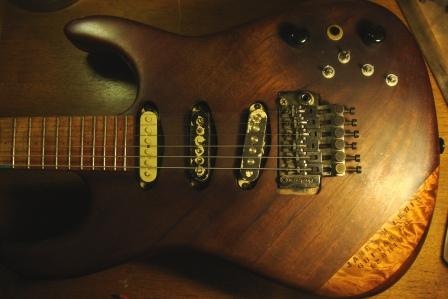 I don't know how many times I've slowed down to take a close look at parts of that guitar (I've got the major hots for your guitar, and might as well admit it), before it occurred to me that the grain was weird. I can't recall ever seeing wood grain in a vaguely-kitty-corner vector like that. Even the guy who cut the Tele body out of the kitchen table made sure to make the grain perfectly perpendicular. On your guitar, though, that explains the added "armrest" of quilted maple, because there wasn't any wood there! It was truly "air guitar." My favorite thing about that guitar is that it's an inspired mix of genius and ... well, I wouldn't call it idiocy as much as "questionable choices" (I wish people gave me the same break once in a while). As soon as I realized that, and why James F. Lewis hit the medicine cabinet a little too hard and whipped out his Harbor Freight stamping kit to emblazon his name on his masterpiece, I was reminded of the granddaddy of all "questionable choices." In his book about Michelangelo; "The Agony and the Ecstacy," Irving Stone wrote that when a promising, pure white block of marble turned up at the quarry in Carrera, the workers considered it a sacred privilege to lug it to the top of a mountain so that Michelangelo could look at it in the first rays of daybreak. That's how he evaluated every piece of marble, and also where the inspiration for the piece took place. In this piece, he saw the whole structure as a pyramid. He saw Mary cradling Jesus, a small, older woman with a full grown man across her lap. By making the lines in the sculpture form a diamond shape (see it?) he was able to subtly enlarge her and shrink Jesus. He made her features youthful to signify purity (common at the time)..  When Michelangelo designed St. Peter's Basilica, he made a special place for the Pieta. So he had the world's greatest masterpiece of sculpture in one of the world's greatest churches. http://www.rome.info/michelangelo/pieta/ "Michelangelo ... achieving a highly polished sheen that made it fairly impossible to believe the sumptuously sculpted figures began as a block of cold stone. Michelangelo's mastery of composition is evident in the unique triangular shape that conveys a stunning grandeur, and a profound knowledge of human anatomy served him well in his creation. According to Giorgio Vasari, shortly after the installation of the Pieta, Michelangelo overheard someone remark that it was the work of another sculptor, Cristoforo Solari. Michelangelo then carved 'MICHAELA[N]GELUS BONAROTUS FLORENTIN[US] FACIEBA[T]' (Michelangelo Buonarroti, Florentine, made it) on the sash running across Mary's breast!" 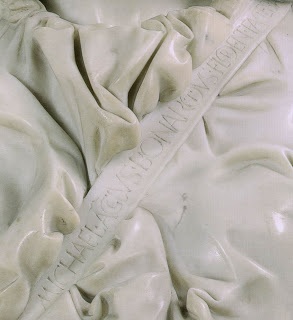 That was the only work he ever signed. He immediately regretted it and it haunted him for the rest of his life. He blamed that mistake for any problems that befell him for the rest of his 88 years. Kinda puts James F. Lewis' "poor impulse control" in perspective, don't it? | ||
| elwoodblue
Senior Member Username: elwoodblue Post Number: 1752 Registered: 6-2002 |
hehe...cool. The auction pics were blurry,bidding on it was a gamble. I could see something going with the bridge assembly,but had no idea really.I thought it could be a version of an MSA bender assembly(google images). It wasn't. The bridge was a floyd rose that had cracked in half,with strings hanging out the back. Luckily I saved the bridge from my 80's Kramer Stryker (wait 'till you see what I've done with the body). When I received the guitar it had a very dark patina,I left it untouched between the knobs. I had to think about if messing with the patina was a good idea.You couldn't see the grain at all before I went at it.I have no regrets about that since it revealed some wood that looks like it was salvaged from a pirate ship that sat in a bog for a century. Your probably right about the armrest area,I've changed designs just to accommodate some crazy figuring in a board. I'm organizing my little woodshop room, I'm curious to see some responses to some of my "questionable choices". (loosens his necktie nervously)  |